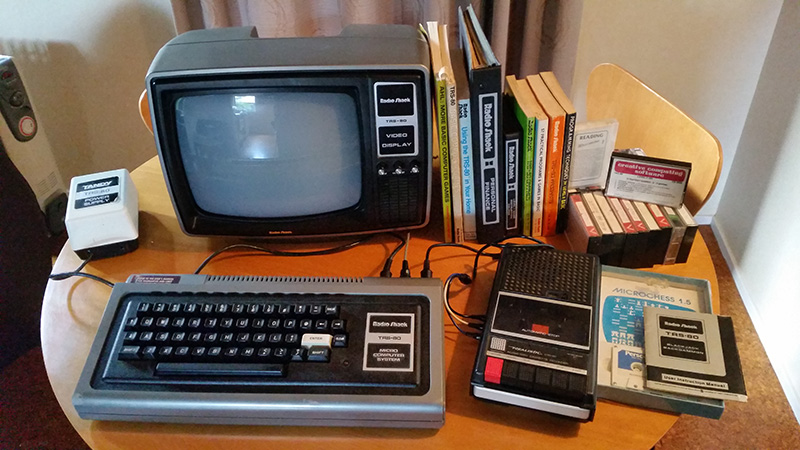Radio Shack TRS-80 Level 1 BASIC Model 1 resurrection
Introduction
There are three microcomputers I covet. These are often called "The Trinity", and all were released in 1977. They were the first across the counter, "plug-em-in and go" consumer computers for the everyman. One was the Commodore Pet 2001, one the Apple II and the other the TRS-80 Level 1 BASIC Model 1. I've got later variations of all three, but have never had any of these first models. Until now.
The photo shows an early TRS-80 Model 1. Note the lack of a numeric keypad. In fact it's a Level 1 BASIC model with a catalogue number of 26-1001 (serial number 061368). The donor was a guy whose father-in-law had kept this machine safely stored for many years. The father-in-law had now passed and his son-in-law wanted to leave it with someone who appreciated its cultural currency.

Figure 1. TRS-80 Level 1 Model 1 haul
As you can see I got a lot more than just the machine. There was a genuine TRS-80 Model 1 monitor, cassette recorder, PSU, a pile of books and original and not-so-original software (A Dick Smith System 80 and screen was also in the mix but that is another story).
I'd been told the computer showed no life, and that was indeed the case. No light..no nothing. However the monitor was perfectly ok and showed a good steady image hooked up to my other TRS-80 Model 1. The PSU also worked. That was a bonus. So, time to jump into the SAMS Computer Facts manual and the Radio Shack TRS-80 Micro Computer Technical Reference Handbook to trace the problem(s) with the main unit.
The faults and the fixes
(a) No power
First thing to look at was the power circuit. Hmm...PSU checked out ok, but no +5V and no +12V in the machine itself. Probing around looking at voltages, 12.3V seemed to be missing on the emitter of Q6 and pin 13 of the L2 regulator.
Figure 2. Zero volts where 12.3 volts should be
The +5V volt circuit requires the +12V one to be working before it can fire up so a fault with Q4 or LM723 regulator was on the cards. My fellow TRS-80 enthusiast Andrew Quinn from Auckland, who was following this repair, put his money on the regulator.
He was right. A trip to the local electronics store saw a replacement regulator IC secured and dropped in. Success!! All voltages were now normal and I now had a bright red power light shining away.
(b) No video
But...(and isn't there always a but?)...nothing was on the screen. Nothing. Zilch. No garbage, no weird letters. Nothing. Hmmm. Time to start tracing the video back from the video jack.
Here's where my patchy electronics knowledge initially led me down a blind alley. I thought there wasn't a signal coming off the Z41 switch IC and that this chip was bad. I replaced it but it made no difference. Turns out there was a signal but I just didn't have the scope settings right. This made me look again at the video circuit downstream. One curious thing was that the emitter on transistor Q2 was at 0V. It was then I read in the reference handbook that the voltage on the base of Q2 should be no higher than 4.4 or the transistor will not switch on. It seem to be just around 4.9V and in fact one time I measured it was as high as 5.3V
Figure 3. Voltage too high on the base of transistor Q2
I traced this unusually high voltage back to the output pin on the composite sync 74C00 IC at Z5. Measuring around this quad 2-input NAND gate revealed normal inputs but screwy outputs. I dropped in a spare, switched on and (after a bit of typing) saw this...Whoo hoo!

Figure 4. It lives!
Figure 5 shows the two ICs that were replaced. Being on the power and video circuits (as opposed to the address and data bus) these faults were relatively straightforward to find.

Figure 5. Circuit board showing the power regulator IC (top right) and 74C00 IC (top left) which were replaced
Last word
You might have noticed that the monitor above is not the one that came with the unit. This is the monitor I normally have with my Level II unit. However, it is an older model monitor than one I received with the Level 1 BASIC unit and hence it seems more appropriate for the latter. I've decide to mate both together and use the newer screen on my 1980, late model Level 2 BASIC TRS-80...the one with the numeric keypad.

Figure 6. A happy TRS-80 Model 1 (Level 1) doing its Level 1 BASIC thing
This Level 1 BASIC model is not QUITE the same as you would have bought over the counter for Xmas in 1977. Rather than 4k of RAM this one has 16. I considered downgrading to to 4k but it just seemed a bit pointless. This venerable machine can be dumbed down at any time so I'll leave it to enjoy its extended memory...for now. (-:
Tez
13 March, 2015
| Tweet |